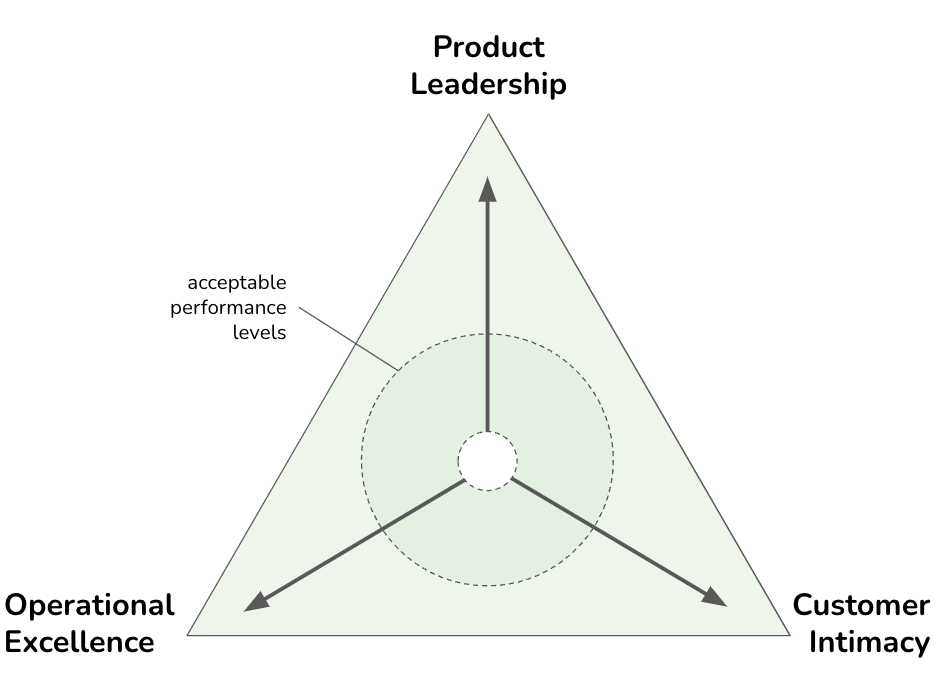Achieving Market Leadership

IN THIS SECTION, YOU WILL: Learn about the Discipline of Market Leader framework taht highlights three distinct strategies for market leadership—operational excellence, product leadership, and customer intimacy.
KEY POINTS:
- Market Leadership Strategies: Companies must choose between operational excellence, product leadership, or customer intimacy as their primary focus, while maintaining baseline competence in the other areas.
- Operational Excellence & IT Architecture: Requires automation, process optimization, and cost-efficient technology solutions such as ERP and supply chain management.
- Product Leadership & IT Architecture: Emphasizes agility, rapid innovation, and integration of research, analytics, and collaboration tools.
- Customer Intimacy & IT Architecture: Focuses on personalized customer experiences, requiring robust CRM systems, data analytics, and seamless omnichannel integration.
- Strategic IT Alignment: IT architecture must be designed to support and reinforce the company’s strategic choice while remaining adaptable to market changes.
Achieving market leadership requires more than just a great product or efficient operations—it demands a strategic focus on how a company creates value for its customers. The Discipline of Market Leader by Michael Treacy and Fred Wiersema outlines three distinct paths to success: operational excellence, product leadership, and customer intimacy. While all businesses must maintain a baseline level of competence in each area, true market leaders excel by committing to one as their core differentiator. Here I briefly explore how these strategic choices impact IT architecture, emphasizing how technology must align with an organization’s chosen path to drive efficiency, innovation, or customer engagement. Understanding these relationships is essential for IT leaders and architects designing systems that support long-term competitive advantage.

Strategic Paths to Market Leadership
The Discipline of Market Leader highlights a company’s three strategic paths to achieve market leadership: operational excellence, product leadership, and customer intimacy (Figure 8):
-
Product Leadership companies provide leading-edge products or practical new applications of existing products or services. Their core process includes invention, commercialization, market exploitation, and disjoint work procedures. Exemplars are Apple, Tesla, Nike, Rolex, and Harley-Davidson.
-
Operational Excellence companies provide reliable products and services at competitive prices, delivered with minimal difficulty or inconvenience. Their value proposition is guaranteed low price and hassle-free service. Which also includes time spent to purchase, future product maintenance, and ease of getting swift and dependable service. The core processes include product delivery, basic service cycle + build on standards, no frills fixed assets. Exemplars are IKEA, McDonald’s, Starbucks, Walmart, and Southwest Airlines.
-
Customer Intimacy companies do not deliver what the market wants but what a specific customer wants. Creating results for carefully selected and nurtured clients. Continually tailors products/services to customers to offer the ‘best total solution.’ Exemplars are Salesforce, LMS Providers, HomeDepot.
 Figure 8: The Discipline of Market Leader model postulates that any successful business needs to maintain at least “acceptable” levels of performance in each of the three dimensions (operational excellence, product leadership, and customer intimacy) but would need to choose one of them to become a market leader in its field.
Figure 8: The Discipline of Market Leader model postulates that any successful business needs to maintain at least “acceptable” levels of performance in each of the three dimensions (operational excellence, product leadership, and customer intimacy) but would need to choose one of them to become a market leader in its field.
The model postulates that any successful business needs to maintain at least “acceptable” performance levels in each of the three dimensions but would need to choose one of them to become a market leader in its field. The model suggests that if you genuinely want to excel in any of the three disciplines, you must make sacrifices in the other two as these become mutually exclusive. By focusing on one (and one only) value to excel at, they beat competitors by dividing their attention and resources among more than one discipline. Each value discipline demands a different operating model to capture the value best. Customers know that expecting superior value in every dimension is unreasonable. You don’t go to Walmart for the best-personalized service or buy Nike sneakers because of low prices.
IT Architecture Role
I found the model helpful in two ways:
- To challenge plans and strategies that are too ambitious, e.g., wanting to excel in all three directions: operational excellence, product leadership, and customer intimacy. It is very complex and expensive to try to build a scalable solution accessible by many users and from many countries while addressing the particular needs of one local customer while doing significant work to innovate around the latest technology hype.
- To prepare for architecting the company’s IT landscape, as different directions require different approaches.
Each direction represents a unique value proposition and requires specific architectural considerations to support it effectively.
- Operational Excellence: This path focuses on delivering products or services at the lowest cost and highest efficiency. The IT architecture should streamline processes, automate repetitive tasks, and optimize resource allocation. It involves leveraging technologies like enterprise resource planning (ERP) systems, supply chain management tools, and process automation solutions to achieve operational efficiency. Scalability, reliability, and cost-effectiveness are critical factors in architectural design.
- Product Leadership: This path involves developing and delivering innovative and superior products or services that differentiate an organization from its competitors. The IT architecture should prioritize flexibility, agility, and the ability to support rapid innovation. Architecture typically emphasizes integrating product development and research systems, data analytics capabilities, and collaboration tools to facilitate idea generation, prototyping, and testing. Ensure that the architecture enables seamless integration with external partners and suppliers to foster a culture of innovation and continuous improvement.
- Customer Intimacy: This path focuses on building strong customer relationships and delivering personalized experiences. The IT architecture should enable customer data collection, analysis, and utilization to gain insights and provide customized solutions. Architectural considerations frequently include complex customer relationship management (CRM) systems, data analytics platforms, and customer engagement tools. Integration with various touchpoints, such as web portals, mobile applications, and social media channels, is essential to deliver a seamless and personalized customer experience.
Incorporating the Discipline of Market Leader into IT architecture design requires aligning technology choices and design decisions with the chosen strategic path. Additionally, the architecture should be flexible enough to adapt to evolving market dynamics and business needs, allowing the organization to switch or combine strategic routes if required.
It is important to remember that the Discipline of Market Leader is not a one-size-fits-all approach, and organizations may need to balance elements from multiple paths based on their specific business context and market conditions.
To Probe Further
- The Discipline of Market Leaders by Michael Treacy and Fred Wiersema, 1993.
Questions to Consider
- Which of the three strategic paths—operational excellence, product leadership, or customer intimacy—best describes your organization’s current market approach?
- How does your company’s IT architecture support its chosen market leadership strategy? Are there areas where alignment could be improved?
- If your organization attempted to excel in multiple strategic paths simultaneously, what challenges would arise in terms of IT infrastructure and business operations?
- How does IT architecture contribute to cost efficiency in an operational excellence strategy?
- In what ways can technology enable product leadership, particularly in fostering innovation and speeding up product development cycles?
- How critical is data analytics and CRM in supporting a customer intimacy strategy, and what architectural components are needed to ensure personalized customer engagement?
- What risks could emerge if IT architecture is not well-aligned with the company’s primary market strategy?
- How can companies ensure that their IT landscape remains flexible enough to shift between strategic paths if market conditions change?
- What role does automation play in improving efficiency across different market leadership strategies, and how should it be architected?
- How should organizations balance investments in core IT infrastructure while also maintaining agility for innovation and customer engagement?
Appendix 5: Notes On Strategy |
|||
| ← | → | ||